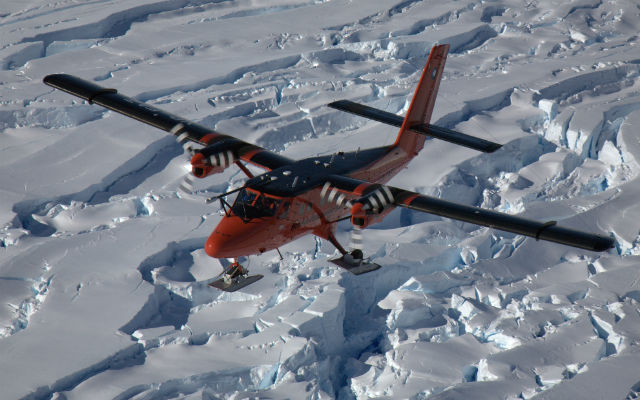The British Antarctic Survey (BAS) is in the process of updating its scientific research fleet, including the addition of an unmanned air vehicle (UAV) and cockpit and sensing upgrades to its manned aircraft.
BAS operates four de Havilland Canada DHC-6 Twin Otters and one DHC-7 Dash 7, but is seeking a fixed-wing UAV of approximately 20kg (44lb) to offer scalable sensing capabilities to complement this manned fleet.
A tender has been released, and responses are due on 4 December 2015 with a contract award expected on 31 December. Two UAVs would initially be required under the £200,000-250,000 ($305,000-$380,000) contract, which would be able to fly from BAS bases and ships, but the longer-term plan would be to acquire more UAVs if the initial introduction of the Twin Otter and Dash 7 is successful.
The UAV would be available off the shelf and be required to carry out flight demonstrations before a contract is awarded. Once a system is selected and delivered, it would gradually be integrated through flight trials during 2016, with a first scientific mission carried out in 2017.
“The key requirements are for us to be able to do over 500km [270nm] with an ideal goal of 1,000km, and be able to put a flexible range of sensors on the platform,” Carl Robinson, head of airborne survey technology at BAS, tells Flightglobal.
A medium-format aerial mapping camera and thermal camera will be used on board at first, followed by other sensors – such as hyperspectral – once the UAVs have been fully integrated into BAS missions.
“A lot of the scientists will be quite happy to get medium-format aerial photography because it ticks a lot of their boxes initially, but some have got very specialist survey applications, such as magnetic and hyperspectral surveys, plus atmospheric,” Robinson added. “So when we’ve shown that the platform can operate, we’ll start to integrate the various sensors for the wider science community.”

British Antarctic Survey
One of the Twin Otters has just undergone an upgrade to include a Garmin G950 glass cockpit, which was completed by Rocky Mountain under the supplemental type certificate (STC) of Aero Corp in October.
“The STC is now there for the rest of the fleet, but we just need to get the money from the government to do the rest,” Rodney Arnold, head of the air division at BAS, said. “There is a financial reason for doing it, because the instruments are so much cheaper, and there is a safety issue because it increases situational awareness and gives a single-crew pilot in a remote, difficult environment a massive advantage.”
The STC covers the upgrade of the whole fleet, but funding is still pending. The aircraft that has been upgraded so far will ideally be tested before rolling the update out to the other three.
“Although we are very confident in the system, you wouldn’t want to change the whole fleet then find out they didn’t work in the South Pole at minus 50 [degrees],” Arnold said.
The Dash 7, meanwhile, has received a new instrument port to allow for it to carry hyperspectral and lidar sensors that have, until now, only been carried by the Twin Otter and a Dornier 228 that BAS is in the process of selling.
This enhancement is still undergoing aerodynamic testing, and the door of the aircraft needs to be made more rigid so that it can be opened and closed mid-flight. A test programme is expected to begin in June or July next year, Arnold said.
The 10h endurance of the Dash 7 in comparison to the 5-7h of the Twin Otter would “massively expand the operational envelope” for carrying these sensors, Arnold added.
“It’s more expensive to fly because it has four engines and two crew, but in terms of the Arctic Ocean, you could fly over the North Pole and still be able to do surveys out there.”
Source: FlightGlobal.com


























